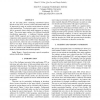Free Online Productivity Tools
i2Speak
i2Symbol
i2OCR
iTex2Img
iWeb2Print
iWeb2Shot
i2Type
iPdf2Split
iPdf2Merge
i2Bopomofo
i2Arabic
i2Style
i2Image
i2PDF
iLatex2Rtf
Sci2ools
ICASSP
2009
IEEE
2009
IEEE
Detecting bandlimited audio in broadcast television shows
For TV and radio shows containing narrowband speech, Speech-to-text (STT) accuracy on the narrowband audio can be improved by using an acoustic model trained on acoustically matched data. To selectively apply it, one must rst be able to accurately detect which audio segments are narrowband. The present paper explores two different bandwidth classi cation approaches: a traditional Gaussian mixture model (GMM) approach and a spline-based classi er that categorizes audio segments based on their power spectra. We focus on shows found in the DARPA GALE Mandarin training and test sets, where the ratio of wideband to narrowband shows is very large. In this setting, the spline-based classi er reduces the number of misclassi ed wideband segments by up to 95% relative to the GMM-based classi er for the same number of misclassi ed narrowband segments.
Related Content
| Added | 21 May 2010 |
| Updated | 21 May 2010 |
| Type | Conference |
| Year | 2009 |
| Where | ICASSP |
| Authors | Mark C. Fuhs, Qin Jin, Tanja Schultz |
Comments (0)

